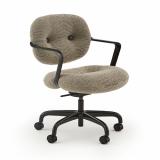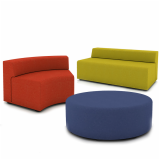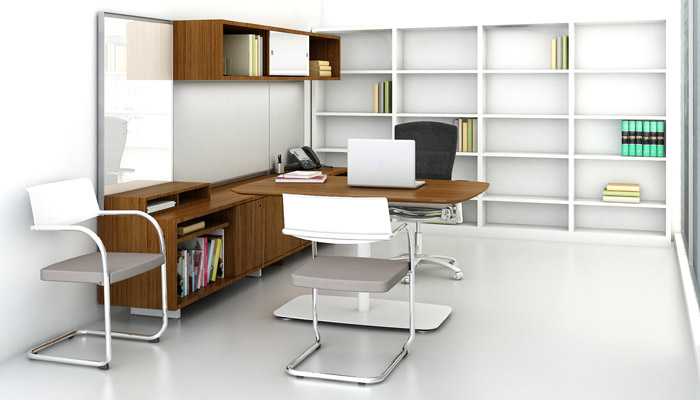
The ubiquitous nature of technology, as well as a preference among today's students for collaboration, has resulted in dramatic shifts in the accepted norms of teaching within higher education facilities.
Put very simply, learning now happens everywhere. Whether in the classroom or the commons, a hallway or the dorm, “teachable moments” (and teachable places) extend well beyond the bounds of the classroom to every corner of the campus, every minute of the day. Consequently, campus design must be re-thought—along with the furnishings.
One area undergoing radical design change is faculty offi ce space. The need to control costs, use space efficiently and support collaboration is necessitating that colleges and universities reduce the workspace allotted to both faculty and staff, but not at the expense of effective, functional—even inspirational—spaces.
Recently, Knoll conducted a study among several American universities to determine the most flexible and efficient means of planning and furnishing the traditional faculty private office with today's needs in mind. Knoll visited with planning and design faculty and professionals at each participating university and found that the responses, needs and planning challenges were remarkably consistent, regardless of age, tenure, field of study and geography.
The study's findings are now being used as the basis for new forward-thinking furnituredesigns to help colleges and universities plan more flexible and efficient office spaces.
Key Findings:
1. Private Offices Still Play a Key Role
While open, multi-use spaces typify the modern university, the private office still plays a prominent role in attracting and retaining top faculty and research staff. In fact, even with the growth in collaborative workplaces, faculty and administrative spaces can still comprise 30 to 50 percent of an institution’s interior spaces. Despite the increased emphasis on collaboration and sharing, the private office provides one of the few tangible elements of stature, status and power that define individuals on campus.
This is particularly true for Baby Boomer instructors, for whom the private office is an important symbol of hierarchy, as well as a reflection of their research or area of specialty. Younger professors, by contrast—perhaps because they are comfortable with mobile devices that allow them to work anywhere—are generally less mindful of the size and location of their workspace.
2. The Private Office Is Shrinking in Size Due to Technology
Due to the growth of wireless technology, tasks that once required a dedicated space and a substantial footprint can now be handled within tighter constraints. Flat-screen monitors, tablets and cloud computing have lessened the need for expansive desktop spaces, with the outcome being that “business as usual” is synonymous with being mobile and wireless within a reduced space. That’s not to imply a one-size-fits-all solution. Whereas older generation professors prefer to be “plugged in,” deskbound and hard-wired, younger generation professors, who are accustomed to the “work anywhere”model, tend to be more portable and find wireless perfectly sufficient. In general, the extent to which an individual professor adapts to a particular space is often a function of his or her technology comfort level, which often correlates with age.
3. Storage Must Be Efficient
In addition to the reduction in the private office footprint, the universal request for access to natural light has given way to new and efficient vertical options for storage. Carving out a windowed office often results in a long, narrow space that necessitates utilizing walls perpendicular to the window for space-efficient storage and display.
Also, because of the value they place on the message their office sends, older faculty members often prefer dedicated space for awards, books and photos that younger faculty might prefer to store on a laptop or tablet.
4. Furniture Must Be Flexible and Technology Accessible
Given the diverse nature of faculty and students, as well as the changing nature of work, teaching, working and learning are in constant flux. A space for desk-bound work in the morning might be a hub of collaboration that same afternoon. Consequently, furnishings must be versatile and adaptable enough to accommodate an impromptu meeting while still providing for individual adjustability and control over space.
Part and parcel to this flexibility is ample technology access and support, which was equal to storage in importance in the minds of those surveyed. With tablets, readers, laptops and smart phones competing with traditional tools for office space, the need for convenient and abundant access to power is critical. In fact, it is especially high in importance among older faculty for whom additional power may be needed in order to illuminate key items on bookshelves or to power up a favorite espresso machine.
5. Expression Is Essential
Regardless of faculty age or length of tenure, expression ranked high on the list of storage priorities for nearly all faculty surveyed. Older faculty, however, place a high value on the message their office sends and consequently often have a higher need for personal expression.
Display areas provide not only a place to store items and books, but also a way of meeting that need. For example, office shelves of older faculty might be occupied with a diverse a mix of items such as books, photos, African jewelry, Egyptian artifacts and a cappuccino machine. By comparison, a younger instructor's version of sharing travel memories might be showing a video from his or her tablet computer since younger faculty tend to be more comfortable with virtual, rather than actual, reminders of their studies, travels and cultural influences. Despite the “generation gap,” personal expression is an across-theboard priority.
DOWNLOAD "Evolving Design of Faculty Offices" TO READ THE FULL PAPER




















